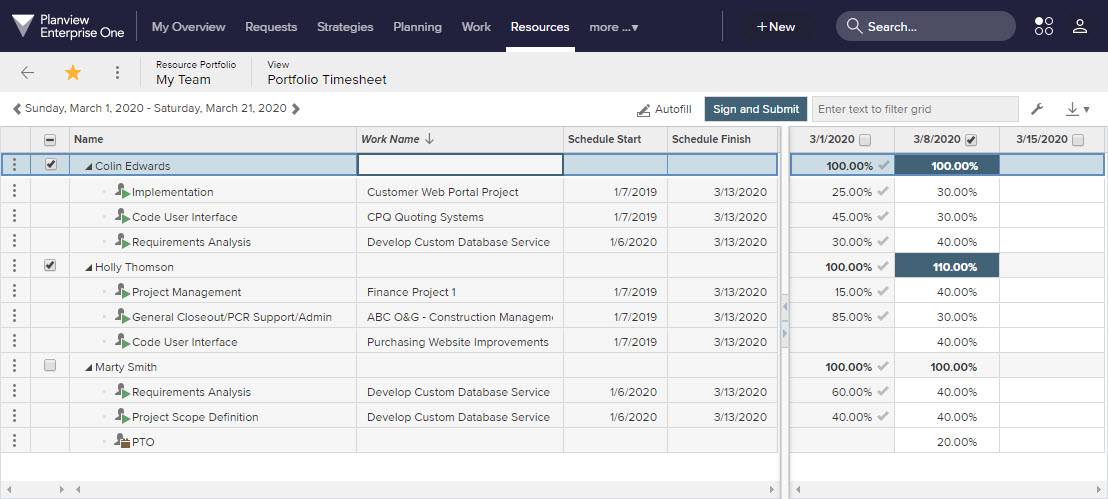
“Timesheets are passé.”
“Nobody wants to do a timesheet!”
“Agile teams don’t report time!”
But…
“All of this capitalization stuff is being pushed very hard by finance.”
“[So we need] rigorous timekeeping against work.”
You may be thinking that I’ve collected these quotes from a variety of Planview customers, but the reality is that these are quotes from within Planview! How can that be? Are timesheets a relic of our traditional past? Or, do they provide critical data to finance and accounting (and by that, I mean data that can increase profits and allow for increased investment funding)?
Well, the answer is really both. There is no doubt that timesheets are a critical data point that impacts the bottom line; but at the same time tracking actuals must be easy and cannot impact productivity. That said, finding the balance between tracking time, minimizing the loss of productivity (not to mention team morale), and layering in the right level of governance can be a challenge.
What is the right answer? And, is it the same for every organization or even the same for everyone within a single organization?
Yes, you already know the answer – one size never fits all – so you really need a set of options that aligns to your specific usage and requirements – both of which can vary considerably within the company.
Capturing actuals in a changing world
You may be thinking that with more and more teams adopting Lean/Agile principles, a traditional timesheet just won’t cut it. The good news is that timesheets have also been evolving. Perhaps without as much fanfare and excitement as the adoption of new Lean/Agile methodologies, but time reporting hasn’t stood still – although I admit that innovations in time reporting don’t always make the headlines.
However, after reading this post, you may think time reporting should make the headlines! Well, maybe it’s not that exciting, but before you stop reading let me provide a quick overview. I’d guess you think you either have people enter timesheets or you don’t. I assure you, that’s no longer the whole story.
There are time reporting options for you – whether you work in a traditional, Lean/Agile, or hybrid world. And, don’t worry if your organization requires more (or less) governance as you can adjust governance as needed. We certainly recognize those needs are often defined in conflicting ways by your various stakeholders, as finance & accounting often have requirements that can differ from other areas.
To accommodate these needs, time tracking can be done in a variety of ways ranging from the traditional timesheet to a fully automated process. The even better news is that you can pick and choose a combination of time reporting and governance options based on requirements within your organization. At a high-level, you have more options now than ever before. Specifically:
- Automatic timesheets with traditional project planning (i.e., actuals based on planned work)
- Automatic timesheets in Lean/Agile organizations (i.e., actuals based on card movement on a Kanban board)
- Manager-level timesheets (i.e., summary time tracking by a team’s manager)
- Individual timesheets
Implementing automatic timesheets
Let’s start with what you probably didn’t expect: Automatic Timesheets.
You may be thinking that this is just a trick to get you to read this section before the subsequent bait and switch, but it’s true!
On the traditional side of the house, where you’re using resource management to plan upcoming project/maintenance work, it’s now possible to simply convert the planned assignments to timesheet actuals. While this relies on the accuracy of the planned work, individuals and managers can also submit time on an exception basis when the planned work differs from what actually happened. Further along the process, individuals and managers can go in and tweak any automatic entry if desired.
And, if finance is worried about accuracy, a quick manager approval can be added to the process to ensure the actuals are correct – so there’s nothing to worry about.
On the Lean/Agile side, we have a more innovative time reporting option – and I have to say I wish it had been my idea!
What if we translate movement of cards on a Planview AgilePlaceTM Kanban board into actual effort on timesheets? While that might sound like black-magic, it’s actually a really great, intuitive process (with a little magic under the covers). You can find more information on the Costing Agile Blog.
How does this work? And what about Operational Expenses or Capital Expenditures?
Accounting standards are complex, but at a high-level, lanes within the Kanban board can be categorized by type of work (e.g., plan, build, support, etc.). When the parent epic is in one of those lanes and the child cards are also in designated lanes allowing capitalization, then that effort will be put into the correct CapEx/OpEx bucket for your finance department.
How can the effort be determined?
In short, as cards are worked, the movement between lanes on the Kanban board, along with the number of active cards for an individual, will drive actuals that are automatically loaded onto a traditional timesheet which includes CapEx/OpEx categories.
Of course, a few more things must come into play to get the accuracy required by finance/accounting. In addition to the number of cards a person is working and the time each card spends in an active lane, the process also looks at the person’s available time. That last part is a bit complex in that it must factor in holidays and planned time-off while also providing a way to handle unexpected time away (as it’s critical to get OpEx/CapEx splits correct). The good news is that those are all taken into account without your users ever touching an actual timesheet!
Working with manager-level timesheets
What if you’re not ready for automated timesheets, but don’t want team-members to submit individual timesheets?
In this case, Planview PortfoliosTM provides managers with the ability to submit high-level timesheets on behalf of their team members. They can simply start with a group of people, use the Portfolio Timesheet which shows planned work by period for everyone. Then, they can adjust to the planned time and submit one or more timesheets with the click of a button. This allows reporting time for the entire period by percentage (rather than typing hours into daily buckets) which can satisfy most governance needs with minimal effort.

You can learn more about Portfolio Timesheets and reporting time for your team by viewing the Planview Portfolios r16 – Team based Time Reporting video.
Using the traditional timesheet
Last but not least, we have traditional timesheets.
I know most people don’t want to submit a timesheet, but it only takes a few minutes per week. If you work in an organization that’s billing other departments or has a high level of governance then this may be the best option. But remember, you can combine any of the above methods in a single environment if you’d like – to focus your effort where it needs to be – rather than on everyone (which no one appreciates).
I should also mention that while much talk these days is around Lean/Agile work, traditional time reporting by far is the most common use-case that I see. Basically, at the end of the week, you log into your timesheet either from your computer or mobile device. You then see your planned work, add anything that wasn’t planned and plug in your time.
It’s not sexy, but at 5-10 minutes per week, it barely slows your exit to the weekend!

Layering on governance
While I’ve mentioned it above, I do want to highlight that all of these options can have a little extra governance layered into the process as required. You can ask managers to manually approve (or disapprove by exception for the fully automatic option) some or all of the timesheets. That process involves a quick look and an approval (or disapproval) with the click of a button, on either your desktop or mobile device. If something is not correct, you can adjust it or send it back to the person submitting it to make a correction.
So, are timesheets are passé?
Not in the least!
They may not be headline-grabbing, but timesheets continue to provide critical information about the work being done which can then be used to drive innovation and split costs into CapEx & OpEx buckets, directly impacting the bottom line. Now, you have more options than ever, so think about what you need and choose the option (or combination of options) that makes life as easy as possible while providing the data and governance your various stakeholders need.
Learn more about time reporting by viewing either the Planview PPM Pro Team Member Role Based Demo or the Team Member Experience in Planview Portfolios Role Based Demo.


![The 2018 Product Portfolio Management Survey Shines A Light on Top Performers [Video]](https://blog.planview.com/wp-content/uploads/2018/06/PDPM-study.gif)
![Planview Recognized as a Leader in 2018 Gartner Magic Quadrant for Project Portfolio Management [Infographic]](https://blog.planview.com/wp-content/uploads/2018/06/Gartner-MQ.gif)


